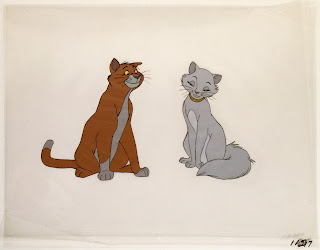Original hand painted and hand inked production cel of Panchito Pistoles; Set on a lithographic background from "The Three Caballeros," 1944; Numbered 722 lower right; Size - Panchito Pistoles: 6 x 3", Image 8 1/4 x 11 1/2"; Unframed.
The film stars Donald Duck, who is joined by his old friend José Carioca, the cigar-smoking parrot from "Saludos Amigos," 1942 (representing Brazil); and later becomes friends with the pistol-packing rooster, Panchito Pistoles (representing Mexico). The film is laid out as a series of individual segments that are connected by Donald Duck opening birthday gifts from his Latin American friends. Several Latin American stars appear in the film including; singers Aurora Miranda (sister of Carmen Miranda) and Dora Luz, and the singer and dancer Carmen Molina.
Panchito's full name is Panchito Romero Miguel Junipero Francisco Quintero González III. Panchito or Pancho (as well as Paco or Paquito) are nicknames for Francisco, his fifth name. Panchito the rooster (who also rides on a horse called Señor Martinez) was animated by Ollie Johnston and Ward Kimball; and was voiced by Joaquin Garay.
Original production cel of Panchito Pistoles without the background.
This is a wonderful cel of Panchito Pistoles. He is eyes and mouth open, full figure, standing with his arms crossed in front of him, and he is wearing his large sombrero. An absolutely perfect pose of this very memorable character!
#TheThreeCaballeros #DonaldDuck #Pablo #PabloPenguin #PablothePenguin #Disney #WaltDisney #SaludosAmigos #JoseCarioca #Panchito #PanchitoPistoles #Mexico #Brazil #LatinAmerica #SmokeyJoe #cel #animation #animationcel #animationdrawing #productioncel #productiondrawing #cartoon #AuroraMiranda #DoraLuz #CarmenMolina #ThreeCaballeros #OllieJohnston #WardKimball #JoaquinGaray #SeñorMartinez





























